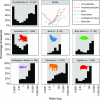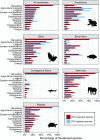Extinction risk is most acute for the world's largest and smallest vertebrates
- PMID: 28923917
- PMCID: PMC5635868
- DOI: 10.1073/pnas.1702078114
Extinction risk is most acute for the world's largest and smallest vertebrates
Abstract
Extinction risk in vertebrates has been linked to large body size, but this putative relationship has only been explored for select taxa, with variable results. Using a newly assembled and taxonomically expansive database, we analyzed the relationships between extinction risk and body mass (27,647 species) and between extinction risk and range size (21,294 species) for vertebrates across six main classes. We found that the probability of being threatened was positively and significantly related to body mass for birds, cartilaginous fishes, and mammals. Bimodal relationships were evident for amphibians, reptiles, and bony fishes. Most importantly, a bimodal relationship was found across all vertebrates such that extinction risk changes around a body mass breakpoint of 0.035 kg, indicating that the lightest and heaviest vertebrates have elevated extinction risk. We also found range size to be an important predictor of the probability of being threatened, with strong negative relationships across nearly all taxa. A review of the drivers of extinction risk revealed that the heaviest vertebrates are most threatened by direct killing by humans. By contrast, the lightest vertebrates are most threatened by habitat loss and modification stemming especially from pollution, agricultural cropping, and logging. Our results offer insight into halting the ongoing wave of vertebrate extinctions by revealing the vulnerability of large and small taxa, and identifying size-specific threats. Moreover, they indicate that, without intervention, anthropogenic activities will soon precipitate a double truncation of the size distribution of the world's vertebrates, fundamentally reordering the structure of life on our planet.
Keywords: biodiversity; body mass; exploitation; extinction; habitat.
Conflict of interest statement
The authors declare no conflict of interest.
Figures











Comment in
-
Reply to Kalinkat et al.: Smallest terrestrial vertebrates are highly imperiled.Proc Natl Acad Sci U S A. 2017 Nov 28;114(48):E10265. doi: 10.1073/pnas.1717570114. Epub 2017 Nov 9. Proc Natl Acad Sci U S A. 2017. PMID: 29122936 Free PMC article. No abstract available.
-
Exceptional body size-extinction risk relations shed new light on the freshwater biodiversity crisis.Proc Natl Acad Sci U S A. 2017 Nov 28;114(48):E10263-E10264. doi: 10.1073/pnas.1717087114. Epub 2017 Nov 9. Proc Natl Acad Sci U S A. 2017. PMID: 29122937 Free PMC article. No abstract available.
-
Reply to Pincheira-Donoso and Hodgson: Both the largest and smallest vertebrates have elevated extinction risk.Proc Natl Acad Sci U S A. 2018 Jun 26;115(26):E5847-E5848. doi: 10.1073/pnas.1805120115. Epub 2018 Jun 13. Proc Natl Acad Sci U S A. 2018. PMID: 29899151 Free PMC article. No abstract available.
-
No evidence that extinction risk increases in the largest and smallest vertebrates.Proc Natl Acad Sci U S A. 2018 Jun 26;115(26):E5845-E5846. doi: 10.1073/pnas.1804633115. Epub 2018 Jun 13. Proc Natl Acad Sci U S A. 2018. PMID: 29899152 Free PMC article. No abstract available.
References
-
- Barnosky AD, et al. Has the Earth’s sixth mass extinction already arrived? Nature. 2011;471:51–57. - PubMed
-
- Pimm SL, et al. The biodiversity of species and their rates of extinction, distribution, and protection. Science. 2014;344:1246752. - PubMed
-
- McCauley DJ, et al. Marine defaunation: Animal loss in the global ocean. Science. 2015;347:1255641. - PubMed
MeSH terms
LinkOut - more resources
Full Text Sources
Other Literature Sources

